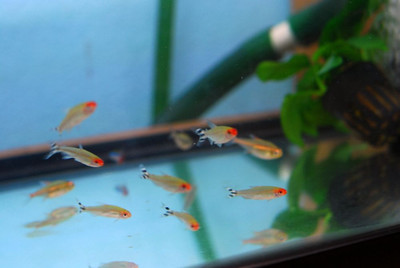Rummynose Tetra
Posted by Max Gandara on on 9th Jul 2025
Rummynose Tetra: The Precision Swimmer of the Aquarium World
If you're looking to add elegance, unity, and activity to your freshwater aquarium, the Rummynose Tetra (Hemigrammus rhodostomus and related species) is one of the most rewarding choices. With their striking red faces, silver bodies, and black-and-white striped tails, these small schooling fish are true aquatic showstoppers.
A Quick Snapshot
-
Common Name: Rummynose Tetra
-
Scientific Name: Hemigrammus rhodostomus (often confused with H. bleheri or Petitella georgiae)
-
Origin: Amazon River Basin, South America
-
Size: Up to 2 inches
-
Temperament: Peaceful, schooling
-
Lifespan: 5–6 years with proper care
The Appeal of Rummynose Tetras
? Unmatched Schooling Behavior
Rummynose Tetras are famous for their synchronized swimming and tightly knit school formations. When kept in a group, they move with mesmerizing precision, making them one of the most graceful species to observe in motion.
? Bold, Bright Coloring
The namesake red snout stands out vividly—especially when fish are healthy and water conditions are ideal. The sharp contrast between their ruby faces and checkerboard tails makes them pop in planted and aquascaped tanks.
? Peaceful and Community-Friendly
These tetras are ideal community fish, especially when housed with other peaceful species. Their calm demeanor makes them great tankmates for dwarf cichlids, rasboras, Corydoras, and other small tetras.
Ideal Aquarium Conditions
Rummynose Tetras thrive in clean, well-maintained aquariums that mimic their natural Amazonian habitat.
✅ Tank Size:
Minimum of 15–20 gallons for a proper school (6+ individuals). Larger groups are always better.
✅ Water Parameters:
-
Temperature: 76–82°F
-
pH: 6.0–7.2
-
Hardness: Soft to moderately hard
-
Tannins: Beneficial; they appreciate driftwood and Indian almond leaves
✅ Aquascape Tips:
-
Dense planting in the background
-
Open swimming areas in the center
-
Driftwood, leaf litter, and subdued lighting help replicate natural conditions
Diet & Feeding
Rummynose Tetras are not picky eaters, but thrive on a varied diet:
-
High-quality micro pellets or flake food
-
Live or frozen foods (daphnia, baby brine shrimp, bloodworms)
-
Occasional vegetable-based foods
Feed small amounts 1–2 times daily to avoid overfeeding and preserve water quality.
Health & Behavior
A healthy Rummynose Tetra has a vivid red nose—a key indicator of water quality and stress. If their nose fades, it’s a sign something is off (poor water parameters, bullying, illness, etc.).
These fish are sensitive to water changes and sudden fluctuations. A slow, steady acclimation process is essential when introducing them to a new tank.
Breeding Notes
Breeding Rummynose Tetras in captivity is possible but requires soft, acidic water and a separate spawning tank. They are egg scatterers, and parents should be removed post-spawning to prevent them from eating the eggs.
Final Thoughts
With their stunning appearance, peaceful nature, and captivating group behavior, the Rummynose Tetra is a top-tier choice for community and aquascaped tanks. They’re a favorite among aquarists for a reason—and once you see them glide in perfect unison across your tank, you'll understand why.
Looking to add movement, contrast, and life to your aquarium? Make room for a school of Rummynose Tetras—they’re elegance in motion.

